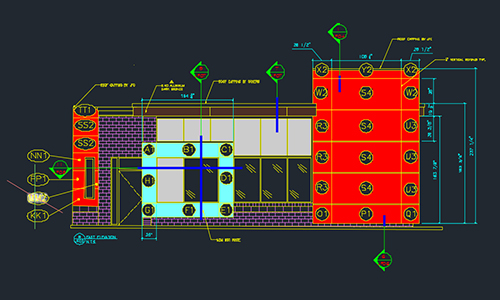What goes into the various kinds of architectural drafting plans?
There are numerous sorts of architectural plans that can be made, each with an alternate arrangement of prerequisites. In the event that you become a planner, it is a great idea to comprehend the essential standards of each kind of Architectural Drafting plan. Underneath you will locate a snappy rundown to get you out and about rapidly.
Architectural drafting plans
Architectural drafting is the advancement of all the important data about the structure from inside the case. As such, the architectural definition manages everything inside the structure and leaves outer plan interests to other people. Architectural drafting services plans are the beginning stage of any architectural composition. The underlying structure starts with the advancement of the underlying illustrations to be exhibited to the customer for remarks and/or endorsement. These illustrations structure the premise of the floor plan.
The floor organizer is a nitty-gritty even course of action and measurements of every physical article in the structure. The floor plans will contain notes and clarify clarifications of explicit materials or development issues that ought to be brought to the consideration of the developer. Landlines likewise go about as a total ‘key’ to demonstrate the initiator where explicit data can be found in various zones of the structure. It isn’t unexpected to figure floor anticipates a scale where the entire structure can be shown – ideally – on a page so it is anything but difficult to see the general measurements, at that point, make plans for Larger ‘impacting’ for zones with a great deal of data, for example, toilets or stairs.
These impact planes are alluded to as discontinuous territories encompassing the region of interest and are named call air pockets showing the root at the location/paper number where the created arrangement exists. Floor plans will likewise profit by segment air pockets and rise showing the area of these subtleties, yet in addition stock images demonstrating the heading wherein subtleties are directed. At last, the commonplace architectural floor plan will likewise contain notes and tables containing space, leave, size and structure estimations that show how the structure configuration meets all pertinent construction regulation necessities.
Earthly maps contain a ton of data and can rapidly make perplexity. Therefore, editors utilize various images, line thicknesses and opening examples to graphically separate what each line and/or territory speaks to in the plane. For instance, it is entirely expected to fill the hole between the different sides of the proposed divider with a space design (a block line, a cross segment of the CMU) in order to be effectively unmistakable, while the divider zones existing ones are typically left clear so the watcher can rapidly recognize the two. The symbols on the dirt guide fluctuate incredibly relying upon the data showed. The electrical floor plan will show images for finding way out, lighting, and switch positions, while the HVAC plan will show pipe falls, indoor regulator, and pipe lifts. The base designs for introducing explicit business data can be partitioned into a solitary sheet or, if the task is little enough, they can be consolidated to show numerous exchanges on each sheet, for instance, pipes and bundling are regularly joined.
Divider areas
The areas of the divider are a long way from the dividers (typically outside) of the structure. They are displayed on a bigger number of shots and offer the content a chance to show nitty gritty data about how the dividers are gathered, what materials are utilized and how they are fixed together.
The divider areas for the most part show everything from the floor to the point where the roof achieves the highest point of the divider. In a multi-story structure, the divider area will likewise demonstrate the crossing point of the floor framework and how it is associated with the divider and emotionally supportive network. These segments for the most part require the vital support in cement and building frameworks, the blaze of the outside divider to counteract water spillage into the structure, the kinds of protection and the inner and outer applications to be connected. Every one of the areas expected to construct a structure are normally gathered on a solitary sheet for simple access.
Detail Sheets
The detail sheets are a lot of broadened illustrations, demonstrating explicit plan zones that require definite data for development. In architectural drafting illustrations, they are typically drawn on an enormous scale (1/2 ‘= 1’0’ or more) to leave space for notes and measurements.
Details are utilized when building necessities in the zone are too unpredictable to even think about displaying on the divider. For instance, it is entirely expected to demonstrate the kinds of feet as subtleties to indicate more data on outfitting steels, which will be hard to peruse on the area of the divider. Numerous subtleties are called ‘ordinary’ in their title, which implies that the data showed is standard for most point by point circumstances. Any example not quite the same as ‘normal’ is drawn as a different detail and is stamped as needs be.
Architectural load and bracing ideas
Lateral Bracing
Lateral bracing is a methods for reinforcing the structure to enable it to withstand wind breaks and seismic occasions. By weight, lodging, the idea of horizontal intelligence is generally executed by outside blurring of the structure. Pressed wood of various thicknesses can be utilized to settle the along the side unsteady casing structure in a homogeneous auxiliary part that uses all the inner segments of the undercarriage to oppose Lateral development. Moreover, it isn’t remarkable and regularly requires an image showing that inside dividers are associated with outside dividers without 25 feet (25 inches).
These inside dividers go about as a horizontal support keeping the external dividers from moving amid pressure. Much of the time, basic fortification of dividers and lift arms is incorporated into the auxiliary structure of the fundamental locales to fortify potential shortcomings. This improvement, frequently alluded to as a cross intersection, is normally utilized at under 18 ‘outside edges, where basic disappointment is more probable. It is regularly used to improve the purposes of contact among cranes and outer dividers to guarantee the reliable coordination of structure between levels. When planning a staggered structure, it is critical to remember the requirement for lower levels to get more side backings than the highest floor. This is because of extra weights added to the size and additional weight. The standard guideline is that the individual story structure requires 20% of the sidebars and you should include an extra 20% for each additional dimension. For the two-story assembling, the primary floor requires 40% of the stents and the second floor 20%.
For the three-story structure, the principal level requires 60%, the second dimension 40% and the third 20%. These figures are signs for the underlying structure and are liable to nearby structure guidelines and the seismic zone in which they work.
Load Calculations
Load figurings are the qualities needed to decide the heap weight on the help components of your structure. Components, for example, the rooftop, snow load, lift weight, floor, and so on. It will put additional strain on your undercarriage and ought to be considered when changing the measure of your help individuals. Things that are joined (winches, floors, and so on.) are typically called inert load, which implies that the measure of the heap they place on your backings does not change. Dead load figurings are performed by increasing the region in square feet of the material’s weight inclusion to decide the pound/square foot (psf) to be upheld. It is critical to incorporate every one of the materials that will be utilized in development Architectural Drafting by architectural drafter when ascertaining perpetual loads. For instance, when ascertaining the changeless heap of a rooftop, you should figure the heaviness of shingles, channels, rafters and protection, just as every single inside completion, for example, gypsum board.
Loads that can be changed are called ‘direct loads’ (snow, individuals, gadgets, and so on.) and are typically determined utilizing a base psf thickness that enables these heaps to be bolstered inside a sensible range. For instance, the most extreme reasonable PSF component at present utilized for the live load is 20 psf for potential measures of float ice, while the immediate heap of the inboard floor is typically 40 psf to permit its utilization by many.
Final Words
Exact charge numbers acknowledged are liable to the prerequisites of nearby structure and division codes. Note that the heaps are total start to finish, that is, the two-story establishments must be intended to help the perpetual heap of the rooftop, rooftop, floors and dividers, just as a two-arrange direct load and a snow load.
JF Constructectek Inc. deals with quality architectural drafting for construction of your houses. Feel free to contact us.

